Read next: 50+ Must-Know Small Business Statistics & Facts for 2024

Create a Business Proposal: Tips, Templates, and Examples
Record, transcribe and summarize conversations with one click.
You're ready to launch. You've got a killer product and you know what you're doing, but do you know how to sell it?
Preparing a business proposal. It's a way of communicating your vision and strategy with others who may be involved in making your business dreams come true.
Business proposals are critical when you're trying to land a new customer. Imagine owning a landscaping business and wanting to work for a new homeowner in your area.
You could email them, "I'm a landscaper, and I can mow your lawn for $20." But that's not very convincing. A better option would be to create a business proposal that explains your experience, the services you offer, and how much they will cost. This way, the homeowner can see that you're serious about your business and know what to expect.
In this article, we'll go over the following:
What a business proposal is
The different types of proposals
What to include in your proposal and how to create one
We'll also give examples and templates to help you get started. By the end, you should know precisely how to write a business proposal to help your business stand out and win more customers.
What is a business proposal?
A business proposal is a formal, written document that outlines the services you're offering, how much they cost, and what benefits your customers will get from working with you. It's also an opportunity to show off your expertise and why you're qualified.
A good business proposal should be easy to read and understand and detailed enough to show that you've put thought and effort into it. A proposal can help secure funding, win a contract, or get a new client. So it's essential to put your best effort into creating one that will impress by doing your research, being specific about what you're offering and why it's critical, and letting the customer know that you understand their needs.
You've probably seen those TV shows where people pitch their business ideas to investors. A business proposal is a lot like that. Still, instead of pitching your idea for funding (or investment), you're using it to get potential customers excited about what you can do—and how you can help solve their problems.
But what makes a business proposal different from a business plan?
A business plan is a document that outlines your entire business. It includes your mission statement, target market, financial projections, and marketing strategy. On the other hand, a business proposal focuses on a specific project or opportunity.
The purpose of a business proposal is to convince someone that your company can provide the services they desire. It should highlight your skills and experience—and explain how those qualities align with the client's needs. A business proposal is often part of the sales process and can aid in securing new customers or winning new projects from existing clients.
2 types of business proposals
There are two main types of business proposals: unsolicited proposals and solicited proposals.
An unsolicited proposal: This is the proposal a business offers without a potential client's request. This means you're reaching out to someone with an idea or solution without them explicitly asking for it. For example, if you own a landscaping business and see a neighborhood with many overgrown lawns, you could create an unsolicited proposal to offer lawn mowing services to the owners.
A solicited proposal: This is the proposal a business offers after a potential client requests through a request for proposal (RFP) or request for quote (RFQ). For example, if you own a marketing agency and receive an RFP from a local company looking for help with their social media marketing, you would create a solicited proposal in response to their request.
Knowing the difference between these two types of proposals is essential because they require different approaches. An unsolicited proposal is a way to introduce yourself and your business to a potential client, while a solicited proposal is a response to a specific request.
Understanding these differences will help you create a proposal tailored to your audience and one that meets their needs.
What you should include in the business proposal
When creating a business proposal, it's crucial to include all the necessary information to convince a potential customer to choose your business. Here are some key elements you should include in your proposal:
An overview of your business
This should be a brief introduction to your business, including what you do, whom you serve, and what sets you apart from other companies in your industry. If you're creating a business proposal for a new client, this is an excellent opportunity to highlight how your services can help them meet their goals.
A good business overview will also include a brief history of your business, including how you started. This section should be no more than two paragraphs long and should not contain any information irrelevant to the proposal.
A description of the problem or need
Please explain the problem or need that the potential customer is facing and how your proposal addresses it. Be specific and use simple language that your audience can easily understand. You can also include relevant statistics or research data supporting your claims.
For example, when writing an email marketing proposal to a potential client who runs a web-based business, you might include statistics that show how many people visit their site each month and the average number of pages they view. This will help demonstrate how your proposal can help them increase sales.
A proposed solution
Outline the solution you're proposing, including the products or services you're offering and how they will solve the customer's problem. Remember to tailor the answer to the customer's needs, and include any research and data supporting your claims.
You want to show that you know what they need and ensure they understand how your solutions will help them achieve their goals.
Present the solution in a way that's easy for your audience to understand, so it's essential to use simple language and avoid jargon. It may be helpful to include visuals or other forms of media (such as infographics) if your audience will better understand what you're offering.
The benefits of your solution
Explain the benefits of your solution, including how it will solve the customer's problem and any additional benefits it offers.
For example, when offering meeting recording and transcribing software, explain its benefits, such as saving time and money by allowing customers to review recordings of meetings and provide feedback on previous discussions. You can also explain how the solution streamlines collaboration, improves productivity, and increases employee satisfaction.
If a customer needs more information about your product or service before purchasing, consider offering additional resources such as a free demo or trial. Consider offering a free consultation with one of your sales representatives who can answer any customer's questions about purchasing your product or service.
Pricing and payment terms
Include details about the cost of your products or services and any discounts or promotions you're offering. You should also include information about payment terms, such as when payment is due and how it will be collected.
A business proposal can be a great way to explain your payment terms. If you're working with an established company, they may have their payment terms in place, so checking before including any specific details about how you receive payments is essential.
Timelines and deliverables
Outline the timeline for completing the project, including any milestones or deadlines. Include details about what you deliver to the customer, such as a finished product or a report.
If you need access to certain information or resources before starting work, include that in the proposal. This can help avoid delays and ensure that both parties are on the same page.
You may also include some basic details about how you'll work with the customer, such as communication methods and whether you're willing to travel for meetings.
Qualifications and experience
Show off your skills and experience by including information about your qualifications and relevant experience. This could consist of education, certifications, or past projects you've completed.
It's also a good idea to include information on any previous relevant projects and your role in completing them. This shows that you have the skills necessary to complete the job.
When starting your career, include some of your goals in the proposal. This shows that you have a passion for what you do and a desire to learn more about the field.
Customer testimonials or case studies
Including customer testimonials or case studies can be a powerful way to demonstrate the effectiveness of your solution. Testimonials can be in the form of written statements or video clips from satisfied customers. This shows how your company's product or service has helped solve a problem for them.
If there are several testimonials, include statistics about how many customers have used your product/service and their results.
Terms and conditions
Include any terms and conditions that apply to your proposals, such as warranties, guarantees, or cancellation policies. You should also include any special instructions or information you want the client to know.
For example, if your business has a policy that prohibits certain types of work while on vacation, be sure to include this in your proposal, so they know what they are getting into. You can also include a section for the client to sign if they accept your proposal. This way, you have documentation of their acceptance and can move forward with the project.
Including these elements in a proposal can communicate the value of your products or services and convince a potential customer to choose your business.
How to write a business proposal
Writing a business proposal can seem intimidating, but it doesn't have to be. By following these 15 easy steps, you'll be able to create a professional and compelling proposal that will help you win more customers.
Step 1: Begin with a title page. The title page should include the name of your company, the date, and the name of the person or company you are submitting the proposal to.
Step 2: Create a table of contents. This will help the reader easily navigate your proposal and find the information they want.
Step 3: State the problem or need. Explain the problem or need that your business is trying to solve. Be specific and provide examples to illustrate the problem.
Step 4: Build out the customer journey. Describe the steps a customer will go through when interacting with your company. This will help the reader understand how your product or service will solve their problem.
Step 5: Qualifications. Discuss your company's qualifications and why you are the best choice to solve the problem. Include information about your experience, skills, and any relevant certifications or awards.
Step 6: Outline your solution. Describe in detail how your product or service will solve the problem. Include any unique features or benefits that set your solution apart from others.
Step 7: Pricing and terms. Include a cost breakdown of the solution and any terms or conditions that apply to your product or service. Also, include relevant information about your company's refund policy, warranty, and other essential details.
Step 8: Supporting documents. Include any additional documents that support your proposal, such as case studies, testimonials, or technical specifications.
Step 9: Conclusion. Summarize your proposal's key points and reiterate why your company is the best choice to solve the problem and deliver a solution. This is the last opportunity to show the customer why they should work with you, not your competitors.
Step 10: Call to action. Please include a clear call to action that tells the reader what you want them to do next, such as setting up a meeting to discuss the proposal further.
Step 11: Contact information. Provide your contact information, including your name, title, phone number, and email address, so the reader knows how to contact you.
Step 12: Close. Thank the reader for reviewing your proposal and asking for their feedback.
Step 13: Review, edit, and send. Take the time to review and edit your proposal to ensure it is clear, concise, and error-free. Print out copies of your proposal and deliver them to the appropriate parties. If you are submitting your proposal electronically, be sure to save it in a PDF format.
Step 14: Follow up. Follow up with the reader to see if they have any questions or need additional information.
Step 15: Negotiate and close the deal. If the reader is interested in your proposal, work with them to finalize the details and close the deal.
A well-written proposal is a critical component of any business deal. It is your best chance to impress the reader and get them excited about your product or service.
With Notta, you can easily generate meeting minutes, turning spoken content into written records with 98.86% accuracy. Stay organized and capture every key detail in your meetings.
10 business proposal templates
A professional business proposal template saves you time and helps you create a more effective proposal. Here are ten business proposal templates to help you get started:
Content marketing proposal
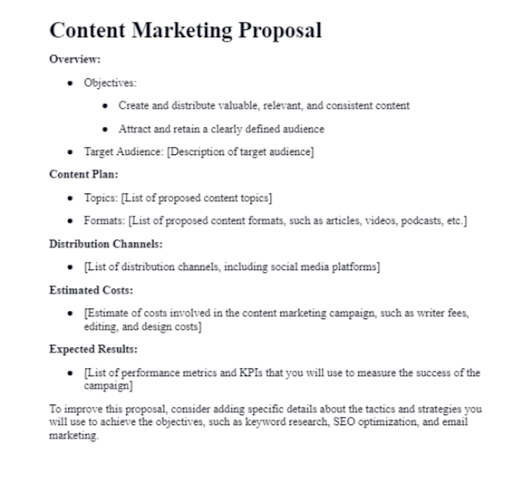
A content marketing proposal outlines a plan for creating and distributing valuable, relevant, and consistent content to attract and retain a clearly defined audience.
A business can use this template to develop a proposal for a client or employer. It includes information about the target audience, proposed content topics and formats, distribution channels (including social media), and estimated costs.
The content marketing proposal should also include the results expected from the campaign, including a detailed list of performance metrics and KPIs. A client may request this proposal instead of or in addition to a traditional project brief or RFP (request for proposal) to better understand how a business will create content that supports its marketing objectives.
Social media marketing proposal
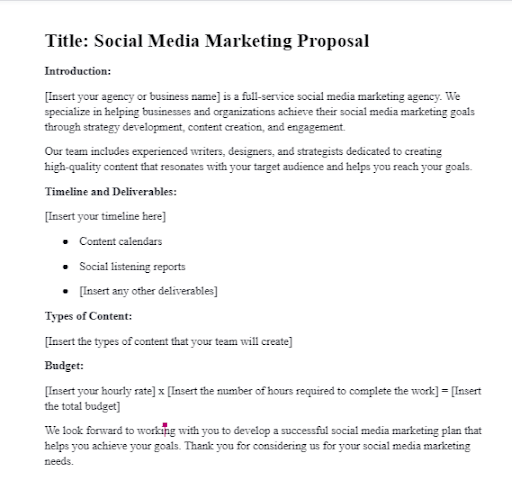
This proposal introduces your agency or business and explains how you can help the client achieve its social media marketing goals. The proposal should include a timeline for implementing the strategy and deliverables, such as content calendars and social listening reports.
It should also provide details about the types of content created and who will make it (including writers, designers, and strategists). The proposal should also include a budget for the work based on an hourly rate multiplied by the number of hours required to complete it.
The proposal will help you start your social media marketing plan and set the stage for executing it with your client.
Business consulting proposal
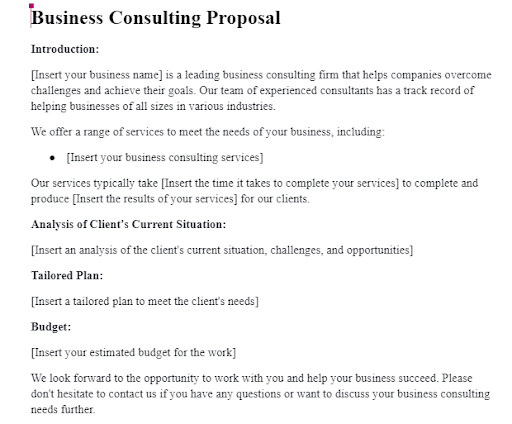
This proposal introduces your business consulting services to potential clients and persuades them to contact you to help them with their business challenges.
You should include information about the services you provide, how long they take to complete, and what results they produce (including client benefits). Your proposal should also have an estimated budget for the work.
Customize a business consulting proposal to a client's specific needs. Remember to include an analysis of the client's current situation, challenges, and opportunities. This will help you develop a tailored plan to meet those needs.
Event planning proposal
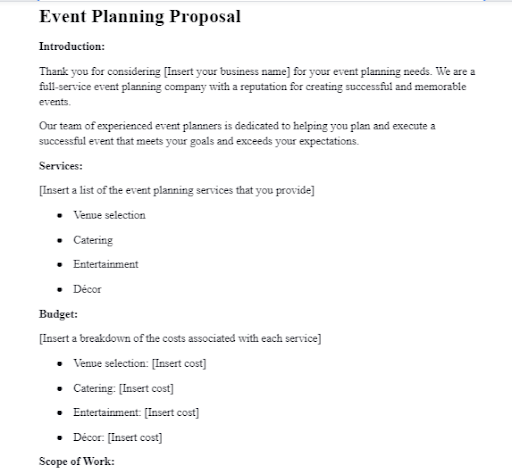
This proposal outlines the event planner's services, including venue selection, catering, entertainment, and décor. Include a budget, timeline, and the costs associated with each item. The proposal should also have a detailed scope of work and event schedule.
This will ensure both parties are on the same page regarding what to expect from each other. It should also include a separate budget for additional services, such as equipment rentals. Remember to tailor the proposal to each client's needs and goals.
Website design proposal
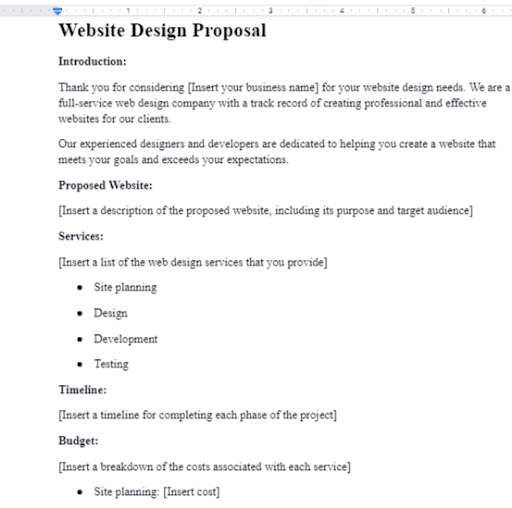
This document outlines a web design company's service, including site planning, design, development, and testing. It also includes a description of the proposed website, including its purpose and target audience.
The proposal should include a timeline for completing each phase of the project and a budget for these services.
The web design proposal is an opportunity to spread your business ideas and convince clients to work with you to create a professional and effective website.
Marketing campaign proposal
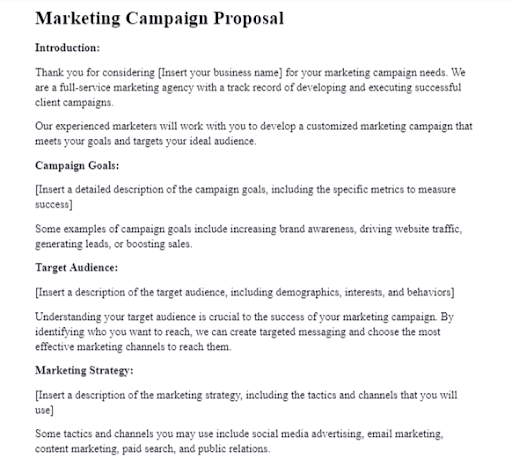
This campaign proposal outlines a plan for promoting a product or service through various marketing channels. It should include a detailed description of the campaign goals, including the specific metrics to measure success.
The proposal also outlines how you will reach your target audience and the resources necessary for each project phase.
There should be an itemized budget for all services your company provides and estimated costs for any outside vendors needed to complete the project.
The marketing campaign proposal should convey all the information necessary for your client to decide whether or not to move forward with the project.
Product launch proposal
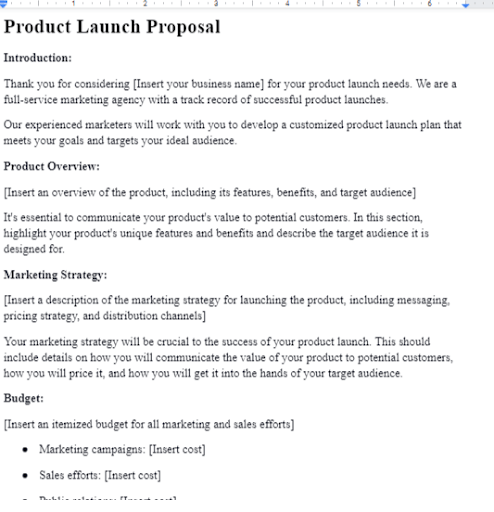
A product launch proposal outlines a plan for introducing a new product to the market, including target audience, messaging, and promotion. You can use it to secure project funding and provide a road map for the company's marketing and sales teams.
The proposal should include an overview of the product, including its features, benefits, and target audience. It should also outline the company's marketing strategy for launching the product, including messaging, pricing strategy, and distribution channels.
Public relations proposal

A public relations proposal outlines a plan for building relationships with the media and other stakeholders to enhance a brand's or organization's reputation. It should include a list of target media outlets and influencers and an outline of the company's messaging strategy.
It should also include a timeline for when the PR campaign begins and ends and any benchmarks to meet before launch. The company should also provide an outline of how it will measure the success of its PR campaigns, such as increased brand awareness and reputation.
Pricing strategy proposal
A pricing strategy proposal outlines the pricing structure for your product or service and explains why you chose it. It should include a list of competitors' prices and estimated manufacturing, distribution, and overhead expenses costs.
It should also include a detailed description of how your pricing strategy will help the company meet its goals, such as increasing sales and market share. If you're proposing a new product or service, consider creating an MVP (minimum viable product) first.
This is a version of your product or service with the minimum viable features. It should be easy to build and test with users. Once you've created an MVP, test it in the real world by getting feedback from potential customers and asking them if they would buy it at different price points. You can then use this information to develop a pricing strategy for your product or service.
Training program proposal
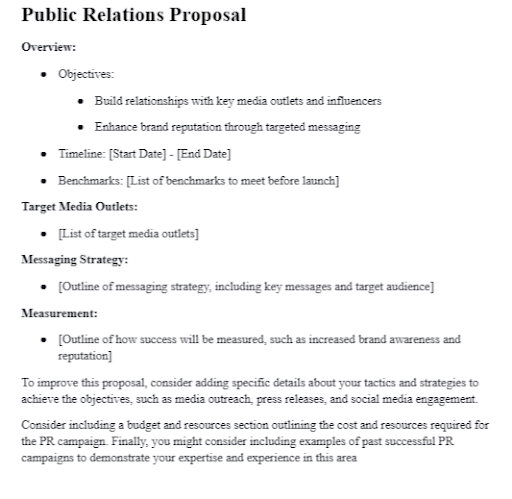
A training program proposal outlines a plan for providing education and skill development to employees or clients. It should include an overview of the program, who it's intended for, what you hope to achieve through it, and how long the program will run. It should also outline the costs involved in delivering the program and how you intend to structure it.
A training program proposal is a great way to present new ideas. It helps you identify potential problems with the program and anticipate questions from stakeholders. It also enables you to get buy-in from stakeholders to help you secure funding or implement your proposal.
Video production proposal
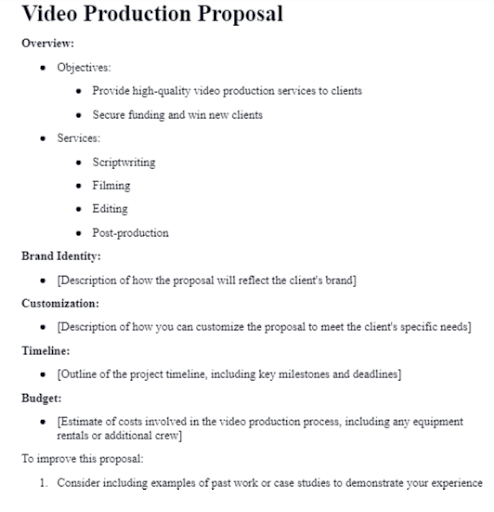
A video production proposal is a document that outlines the services a video production company will provide, including scriptwriting, filming, editing, and post-production.
A professionally designed business proposal template can help you create a professional, high-quality document that will help you secure funding, win new clients, and retain existing ones.
These templates are customizable, easy to edit, and can work for any business, from small start-ups to large corporations. You can customize them to reflect your brand and make it stand out from competitors.
Having a format business proposal template can save you time and help you create a more effective proposal.
5 business proposal examples
Here are five business proposal examples to give you an idea of how a proposal might look and the type of information it might include:
Example 1: Marketing services proposal
This format business proposal is for a marketing agency offering its services to a potential client. The proposal includes a cover letter, a table of contents, and several sections detailing the agency's qualifications, marketing strategy, and pricing. There is also a section on the agency's past clients and case studies to showcase their experience and success.
Example 2: Event planning proposal
This proposal is for an event planning company that is offering its services for a company's annual conference. The proposal includes a cover letter, a table of contents, and several sections detailing the event planning process, budget, and timeline. There are also sections on the company's experience, testimonials from past clients, and photos of events they planned.
Example 3: Software development proposal
This format business proposal is for a software development company offering its services to a potential client. The proposal includes a cover letter, a table of contents, and several sections detailing the company's process for developing custom software, qualifications, and pricing. There are also sections on the company's past projects and technical capabilities.
Example 4: Consulting services proposal
This proposal is for a consulting company offering its services to a potential client. It includes a cover letter, a table of contents, and the company's qualifications, consulting process, and pricing. It also has sections on the company's past clients and case studies to showcase their experience and success.
Example 5: Website design proposal
This proposal is for a website design and development company offering its services to a potential client. The proposal includes the following:
A cover letter
A table of contents
The company's process for designing and developing websites
Its qualifications
Pricing
There are also sections on the company's past projects and design portfolio to showcase its experience and skills.
These business proposal examples give you an idea of the types of information to include in your proposal. Remember, every proposal will differ depending on the product or service offered and the potential client's needs.
Tips for business proposal
Start with an outline: Before you start writing your proposal, it's a good idea to create an overview of the key points you want to include. This will help you organize your thoughts and ensure that your proposal is structured and easy to follow.
Use data and visuals: Including data and visuals in your proposal can help make your case more effective. Use charts, graphs, and other visuals to illustrate your points and make your proposal more engaging.
Integrate video: Adding a video to your proposal can make it more dynamic and engaging. You can use video to introduce yourself or your company or to demonstrate your products or services.
Customize your proposal: Don't send the same proposal to every potential customer. Take the time to customize your proposal to fit each customer's specific needs and goals.
Keep it concise: A long, rambling proposal can be overwhelming and challenging to read. Keep your proposal brief and to the point to make it more effective.
Use a professional design: A well-designed proposal looks professional and shows that you take your business seriously. Invest in a good design for your proposal to make a good impression on your potential customers.
Use bullet points: Bullet points can help you organize your thoughts and make your proposal easier to read. Use bullet points to break up large blocks of text and highlight key points.
Use strong headlines: Headlines are essential for grabbing the reader's attention and helping them understand the main points of your proposal. Use solid and descriptive headlines to make your proposal more effective.
Include customer testimonials: Including customer testimonials in your proposal can help you build credibility and demonstrate the effectiveness of your products or services.
Use case studies: Case studies are a powerful way to demonstrate the value of your products or services. Include case studies in your proposal to show how you have helped similar customers and what the results were.
Offer options: Offering different options or packages in your proposal can give your potential customers more flexibility and make it easier for them to choose a solution that works for them.
Be transparent: Be upfront and honest about your proposal's costs, timelines, and expectations. Transparency will help build trust and make it easier for your potential customer to decide.
Proofread: Don't let typos or grammatical errors ruin your proposal. Take the time to proofread and double-check your proposal to ensure it's error-free.
Stay organized: Keep track of your proposals and the responses you receive. Use a spreadsheet or project management software to manage your proposals to stay organized and on top of your sales efforts.
By following these tips, you can create a professional and effective business proposal that will help you win more customers.
Key takeaways
A business proposal is crucial for bridging the gap between businesses and potential clients. By outlining the problem, proposed solution, and benefits of your products or services, you can showcase your professionalism and experience and convince potential clients to choose your business.
While there are no set rules or guidelines on how to write a proposal, you can create a professional and compelling proposition by following the steps outlined in this article and using templates as a guide.
Remember to tailor your proposal to your client's specific needs and goals, and use the tips to create a proposal that will impress.